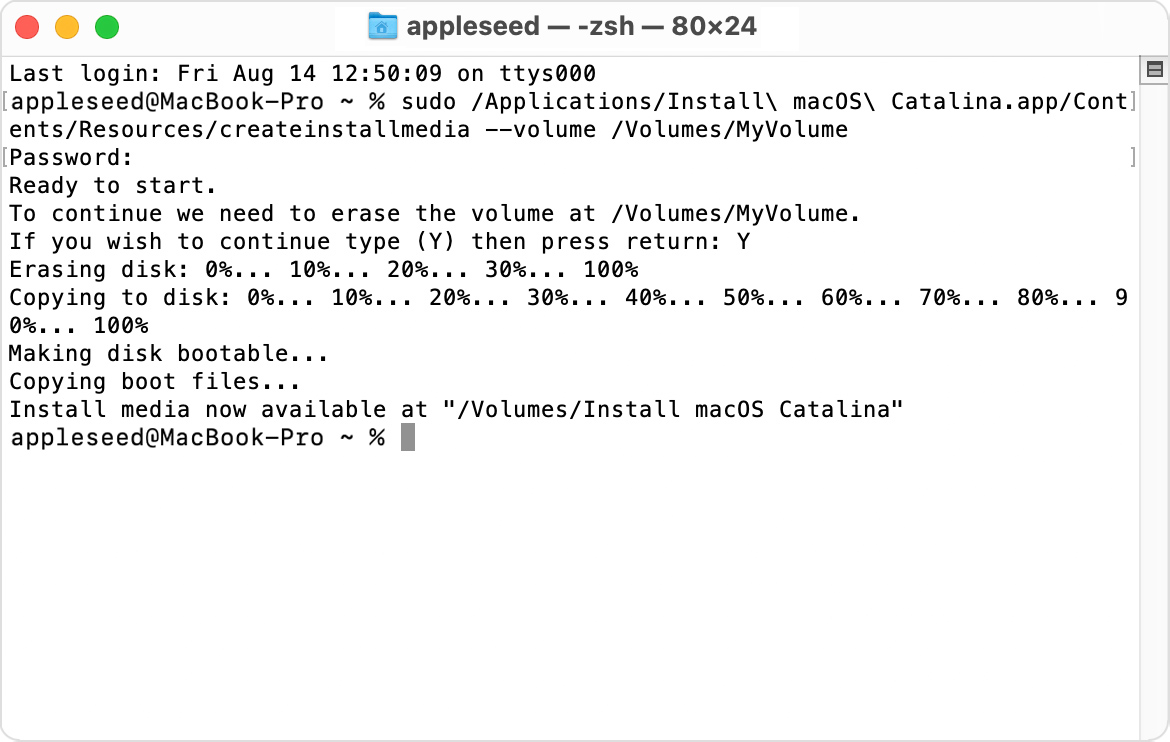Mac Os X Bootable Cd Image Download
How to create a bootable installer for macOS
You tin use an external drive or secondary book as a startup deejay from which to install the Mac operating arrangement.
These advanced steps are primarily for organisation administrators and others who are familiar with the command line. You don't demand a bootable installer to upgrade macOS or reinstall macOS, merely information technology can exist useful when you want to install on multiple computers without downloading the installer each fourth dimension.
What y'all need to create a bootable installer
- A USB wink drive or other secondary volume formatted every bit Mac Bone Extended, with at least 14GB of available storage
- A downloaded installer for macOS Monterey, Big Sur, Catalina, Mojave, High Sierra, or El Capitan
Download macOS
The installer for macOS Monterey,macOS Big Sur,macOS Catalina,macOS Mojave, ormacOS High Sierra downloads to your Applications folder as an app named Install macOS [version proper name]. If the installer opens subsequently downloading, quit it without continuing installation. To get the correct installer:
- Download on a Mac that is compatible with that version of macOS.
- Download on a Mac that is using macOS Sierra 10.12.v or later, or Bone Ten El Capitan 10.11.vi.
- Enterprise administrators: Download from Apple, not a locally hosted software-update server.
The installer for OS Ten El Capitan downloads to your Downloads folder as a disk paradigm named InstallMacOSX.dmg. To go the installer:
- Download using Safari, and open up the deejay paradigm on a Mac that is uniform with Os Ten El Capitan.
- Inside the disk paradigm is an installer named InstallMacOSX.pkg. Information technology installs an app named Install OS X El Capitan into your Applications binder. You volition create the bootable installer from this app, not from the disk prototype or .pkg installer.
Apply the 'createinstallmedia' command in Terminal
- Connect the USB wink bulldoze or other volume that you lot're using for the bootable installer.
- Open up Final, which is in the Utilities binder of your Applications folder.
- Type or paste one of the following commands in Terminal. These presume that the installer is in your Applications folder, and MyVolume is the name of the USB flash drive or other volume you're using. If it has a dissimilar name, replace
MyVolumein these commands with the name of your volume.
Monterey:*
sudo /Applications/Install\ macOS\ Monterey.app/Contents/Resources/createinstallmedia --volume /Volumes/MyVolume
Big Sur:*
sudo /Applications/Install\ macOS\ Big\ Sur.app/Contents/Resource/createinstallmedia --volume /Volumes/MyVolume
Catalina:*
sudo /Applications/Install\ macOS\ Catalina.app/Contents/Resources/createinstallmedia --volume /Volumes/MyVolume
Mojave:*
sudo /Applications/Install\ macOS\ Mojave.app/Contents/Resources/createinstallmedia --volume /Volumes/MyVolume
High Sierra:*
sudo /Applications/Install\ macOS\ High\ Sierra.app/Contents/Resources/createinstallmedia --book /Volumes/MyVolume
El Capitan:
sudo /Applications/Install\ OS\ X\ El\ Capitan.app/Contents/Resources/createinstallmedia --volume /Volumes/MyVolume --applicationpath /Applications/Install\ OS\ Ten\ El\ Capitan.app
* If your Mac is using macOS Sierra or earlier, include the--applicationpath argument and installer path, like to the way this is done in the command for El Capitan.
Afterwards typing the command:
- Press Render to enter the command.
- When prompted, type your ambassador password and press Return again. Terminal doesn't show whatsoever characters every bit you type your password.
- When prompted, blazon
Yto confirm that you want to erase the volume, so printing Render. Terminal shows the progress as the volume is erased. - After the book is erased, you may see an alarm that Final would similar to access files on a removable volume. Click OK to allow the copy to go along.
- When Terminal says that it's done, the book will have the same name as the installer you downloaded, such as Install macOS Monterey. You can now quit Concluding and eject the volume.

Employ the bootable installer
Apple silicon
- Plug the bootable installer into a Mac that is connected to the cyberspace and uniform with the version of macOS yous're installing.
- The macOS version that came with the Mac is the earliest version it can utilize.
- A bootable installer doesn't download macOS from the internet, only information technology does require an net connectedness to get firmware and other information specific to the Mac model.
- Turn on the Mac and continue to hold the power button until yous see the startup options window, which shows your bootable volumes.
- Select the volume containing the bootable installer, and so click Continue.
- When the macOS installer opens, follow the onscreen instructions.
Intel processor
- Plug the bootable installer into a Mac that is connected to the net and uniform with the version of macOS you're installing.
- The macOS version that came with the Mac is the primeval version it can use.
- A bootable installer doesn't download macOS from the internet, only it does crave an internet connectedness to go firmware and other data specific to the Mac model.
- Press and hold the Selection (Alt) ⌥ key immediately later on turning on or restarting the Mac.
- Release the Option primal when you lot see a night screen showing your bootable volumes.
- Select the volume containing the bootable installer. Then click the up arrow or press Return.
If you can't offset upwards from the bootable installer, make sure that Startup Security Utility is set to let booting from external or removable media. - Choose your language, if prompted.
- Select Install macOS (or Install Os X) from the Utilities window, then click Continue and follow the onscreen instructions.
Larn more
For information about the createinstallmedia command and the arguments you can utilize with it, make certain that the macOS installer is in your Applications folder, then enter the appropriate path in Terminal:
/Applications/Install\ macOS\ Monterey.app/Contents/Resources/createinstallmedia
/Applications/Install\ macOS\ Big\ Sur.app/Contents/Resources/createinstallmedia
/Applications/Install\ macOS\ Catalina.app/Contents/Resource/createinstallmedia
/Applications/Install\ macOS\ Mojave.app/Contents/Resources/createinstallmedia
/Applications/Install\ macOS\ High\ Sierra.app/Contents/Resource/createinstallmedia
/Applications/Install\ OS\ X\ El\ Capitan.app/Contents/Resources/createinstallmedia
Published Date:
Mac Os X Bootable Cd Image Download
Posted by: florenceclooke.blogspot.com
![Download Drive SnapShot 1.47.0.18544 Crack + Serial Key [Latest Version] FREE Download Drive SnapShot 1.47.0.18544 Crack + Serial Key [Latest Version] FREE](https://1.bp.blogspot.com/-FxxoZkxtk_U/WKAvV2Gd6iI/AAAAAAAACd0/UTrLC-1x23k1E0oqRLErM2XliW2XDiBlQCK4B/s1600/dif.jpg)


0 Komentar
Post a Comment